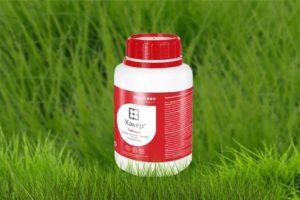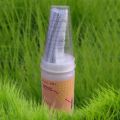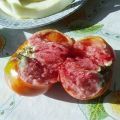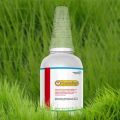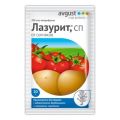Instructions for the use of herbicide Caliber, consumption rates and analogues
"Caliber" is widely used in agriculture, the herbicide is effective against dicotyledonous weeds. A highly effective drug based on innovative technologies has been developed. Two components in its composition affect the growth points of weeds and suppress cell division. The remedy works even on the fields very overgrown with weeds. Crops are treated at any stage of weed development.
Content
- 1 Composition, release form of the herbicide "Caliber"
- 2 How does the remedy work
- 3 Main advantages and disadvantages
- 4 List of cultivated crops and rate of consumption
- 5 Preparation of working solution
- 6 Instructions for the use of the herbicide
- 7 Safety engineering
- 8 Toxicity degree
- 9 When not to use?
- 10 Drug compatibility
- 11 Storage rules
- 12 Similar means
Composition, release form of the herbicide "Caliber"
The pesticide belongs to the sulfonylurea class. The composition includes thifensulforon-methyl at a concentration of 500 g / kg and tribenuron-methyl 250 g / kg. The product is produced in the form of water-dispersible granules of 0.5 kg in a package from a plastic can with a measuring cup.

How does the remedy work
The active components of the herbicide begin to act immediately after treatment. They penetrate the leaf plates, move to growth points. The enzyme aceolactate synthase stops its activity. After 2 hours, cell division in weeds ceases to occur. They cannot consume moisture, nutrients and do not interfere with the growth and development of crops. Violation of the formation of chlorophyll and photosynthesis and wilting of weeds is observed after 5 days, after 15-20 they completely die. In warm and humid weather, the process is faster. The herbicide works when the air temperature is +5 FROM.
Main advantages and disadvantages
Agrarians characterize the herbicide as an effective remedy and note its advantages:
- destruction of a wide variety of dicotyledonous weeds growing in grain crops: both winter and spring;
- selective action for cereals: wheat, barley, from the beginning of the second phase until the formation of the flag leaf;
- grasses die after 14 days, the agent has no effect on wheat, barley;
- acts on heavily overgrown areas;
- the processing time can be different: when the weeds have just appeared and in the case of their overgrowth;
- low toxic to bees and humans;
- there are no restrictions for crop rotation - the substance decomposes in the soil in a short time, after harvesting grain in the autumn or spring, it is allowed to sow any crops.
- "Caliber" guarantees a high yield;
- you can spray from the ground and from the plane.
Among the shortcomings, the high price of the drug is distinguished - about 15 thousand rubles per 1 kg.

List of cultivated crops and consumption rate
The chemical is effective against annual and perennial weeds:
- ambrosia, geranium, warthog, black mustard;
- cornflower, Galinsoga 4-rayed and small-flowered, vetch sowing;
- field bindweed;
- foresters, carrion;
- highlander, nettle, oxalis;
- stellate, string, yaruk;
- clover, lettuce;
- chamomile, violet, resin;
- schiritsa, lamb.
From annual species of dicotyledonous weeds, which are highly sensitive, in the phase of 2-6 leaves, and when sow thistle, thistle in the rosette stage, 30 g / ha is required.
For bedstraw (whorl), veronica, violet, ragweed, quinoa, dandelion - 40 g / ha.
If there are many weeds, and if they have overgrown (cornflower, bedstraw, bindweed) - 50 g / ha.

Preparation of working solution
"Caliber" is diluted just before spraying. The container is filled with water by ½, the stirrer is turned on, the required amount of "Caliber" granules is added. Turn off the mechanism and dissolve Trend 90. It enhances the effect, acts as an adhesive. Then more water is poured. When mixed with other pesticides, first of all dissolve "Caliber", then a compatible agrochemical and then "Trend 90". Spray in dry weather without wind.
Instructions for the use of the herbicide
Processing is carried out using ground or air technology. It is necessary to adhere to the dosage and spraying rules.
| Rate g / ha | Culture | Weeds | Consumption | Processing features |
| 30-50 | Spring and winter crops: wheat, barley
| Annuals, perennial dicotyledons | 200-300 l / ha, when processing from an aircraft - 50-100 l / ha | The first stages of weed growth, sowing of 2-3 leaves before the formation of a tillering node. Also with the addition of "Trend 90" and at the stage of entering the grain tube (1-2 internodes) |
| 30-50 (A) | Winter wheat and barley | 200-300 l / ha, with aerial processing - 50-100 l / ha. | In the spring, when crops are tillering, weeds are in the initial stage of growth. Also with "Trend 90" and at the stage of stem elongation or emergence into the seed tube |
Safety engineering
Before breeding and processing, be sure to wear protective equipment: work suit, gloves, mask. After rinse the clothes, wash the exposed parts of the body thoroughly, rinse the mouth. Persons with disorders of the nervous system, gastrointestinal tract, liver, heart, respiratory organs should not be sprayed with herbicide.
Toxicity degree
The herbicide belongs to the 3rd class of toxicity. For humans and bees, it is of little danger. It cannot be used in the water protection zone.

When not to use?
It is forbidden to carry out processing:
- if rain is predicted in 3 hours;
- crops have not dried up from dew, rain.
When crops are stressed by drought or frost, you should also avoid using a herbicide. The air temperature should warm up to +5 C. Avoid spilling the solution on nearby growing crops. With a large accumulation of weeds, collect the maximum amount of liquid.
Drug compatibility
"Caliber" is combined with insecticides and fungicides, which are permitted for spraying weeds on grain crops. It is not recommended to mix the drug with organophosphorus agrochemicals.

Storage rules
The finished solution must be used within a day. It is necessary to store the container with the packed substance in a dry, cool place, where the temperature is not lower than +5 FROM.
Similar means
There are herbicides with the same active substance: "Harmony", "Tifi", "Grenadier Maxi", "Alpha Guard VDG".
Similar drugs with other active ingredients: "Disulam", "Anlantis", "Promeks".
